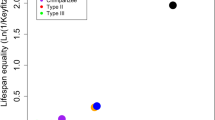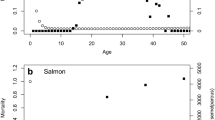Abstract
For two genotypes that have the same mean number of offspring but differ in the variance in offspring number, naturalselection will favor the genotype with lower variance. In such cases, the average growth rate is not sufficient as a measure of fitness or as a predictor of fixation probability. However, the effect of variance in offspring number on the fixationprobability of mutant strategies has been calculated under several scenarios with the general conclusion that variance in offspring number reduces fitness in proportion to the inverse of the population size [Gillespie, J., Genetics 76:601–606, 1974; Proulx, S.R., Theor. Popul. Biol. 58:33–47, 2000]. This relationship becomes more complicated under a metapopulation scenario where the “effective” population size depends on migration rate, population structure, and lifecycle. It is shown that in a life cycle where reproduction and migration (the birth-migration-regulation life cycle, or BMR)occur prior to density regulation within every deme, the fitness of a strategy depends on migration rate. When migration rates are near zero, the fitness of the strategy is determined by the size of individual demes, so that the strategy favoredin small populations tends to be fixed. As migration rate increases and approaches panmixis between demes, the fitness ofa reproductive strategy approaches what its value would be in a single, panmictic deme with a population size correspondingtothe census size of the metapopulation. Interestingly, when the life cycle is characterized by having density regulation in each deme prior to migration (the BRM life cycle) the fixation probability of a strategy is independent of migration rate. These results are found to be qualitatively consistent with the individual-based simulation results in Shpak [Theor. Biosci.124:65–85, 2005].
Similar content being viewed by others
References
Charnov, E.L., Schaffer, W.M., 1973. Life history consequences of natural selection: Cole’s result revisited. Am. Nat. 107, 791–793.
Cherry, J.L., Wakeley, J., 2003. A diffusion approximation for selection and drift in a subdivided population. Genetics 163, 421–428.
Crow, J.F., Kimura, M., 1970. An Introduction to Population Genetics Theory. Harper and Row, New York.
Demetrius, L., Gundlach, M., 1999. Evolutionary dynamics in random environments. In: Crauel, H., Gundlach, M. (Eds.), Stochastic Dynamics. Springer-Verlag, New York, pp. 371–394.
Demetrius, L., Gundlach, M., 2000. Game theory and evolution: Finite size and absolute fitness measures. Math. Biosci. 168, 9–38.
Ewens, W.J., 2004. Mathematical Population Genetics. Springer-Verlag, New York.
Gardner, A., West, S.A., 2006. Demography, altruism, and the benefits of budding. J. Evol. Biol. (in press).
Gillespie, J., 1974. Natural selection for within-generation variance in offspring number. I. Genetics 76, 601–606.
Gillespie, J., 1975. Natural selection for within-generation variance in offspring number. II. Genetics 81, 403–413.
Gillespie, J., 1977. Natural selection for variance in offspring numbers: A new evolutionary principle. Am. Nat. 111, 1010–1014.
Haldane, J.B.S., Jayakar, S.D., 1963. Polymorphism due to selection of varying directions. J. Genet. 58, 237–242.
Karlin, S., Taylor, H.M., 1975. A First Course in Stochastic Proccesses. Academic Press, New York, NY.
Kimura, M., 1964. The diffusion model in population genetics. J. Appl. Probab. 1, 177–232.
Nowak, M.A., Sasaki, A., Taylor, C., 2004. Emergence of cooperation and evolutionary stability in finite populations. Nature 428, 646–650.
Proulx, S.R., 2000. The ESS under spatial variation with applications to sex allocation. Theor. Populat. Biol. 58, 33–47.
Proulx, S.R., Day, T., 2001. What can invasion analyses tell us about evolution under stochasticity in finite populations? Select. Mol. Genes Memes 2, 2–15.
Queller, D.C., 1992. Does population viscosity promote kin selection? Trends Ecol. Evol. 7, 322–324.
Seger, J., Brockmann, H.J., 1987. What is bet-hedging? In: Harvey, P.H., Partridge, L. (Eds.), Oxford Surveys in Evolutionary Biology, vol. 4. Oxford University Press, Oxford, pp. 182–211.
Shpak, M., 2005. Evolution of variance in offspring number: The effect of population size and migration. Theor. Biosci. 124, 65–85.
Stearns, S.C., 2000. Daniel Bernoulli: Evolution and economics under risk. J. Biosci. 25, 221–228.
Wade, M.J., 1985. Soft selection, hard selection, kin selection, and group selection. Am. Nat. 125, 61–73.
Wakeley, J., Aliacar, N., 2001. Gene genealogies in a metapopulation. Genetics 159, 893–905.
Wallace, B., 1968. Topics in population genetics. W.W. Norton, New York, NY.
Whitlock, M.C., Barton, N.H., 1997. The effective size of subdivided population. Genetics 146, 427–441.
Wild, G., Taylor, P.D., 2004. Fitness and evolutionary stability in game theoretic models of finite populations. Proc. R. Soc. Lond. Ser. B 2345–2349.
Author information
Authors and Affiliations
Corresponding author
Additional information
An erratum to this article can be found at http://dx.doi.org/10.1007/s11538-007-9211-3
Rights and permissions
About this article
Cite this article
Shpaka, M., Proulx, S.R. The Role of Life Cycle and Migration in Selection for Variance in Offspring Number. Bull. Math. Biol. 69, 837–860 (2007). https://doi.org/10.1007/s11538-006-9164-y
Received:
Accepted:
Published:
Issue Date:
DOI: https://doi.org/10.1007/s11538-006-9164-y




